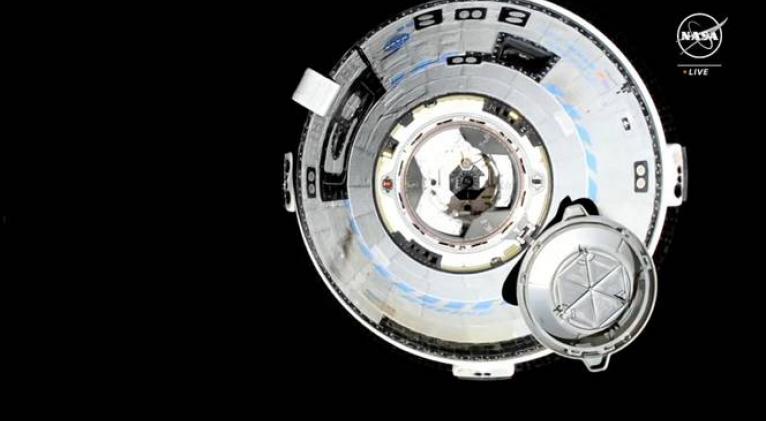What happened to the NASA astronauts aboard Boeing's Starliner spacecraft?
especiales

Two astronauts will need to make themselves at home in the International Space Station (ISS) for the time being.
Following a series of delays, and with no return date scheduled yet, American astronauts Sunita 'Sunni' Williams, 58, and Barry 'Butch' Wilmore, 61, are essentially stuck on the ISS due to issues with the Boeing spacecraft that carried them into orbit on June 5 before arriving at the outpost the next day.
The mission is the first crewed test flight of Boeing's Starliner. The original plan was for the two veteran astronauts to spend about a week in space, but last week, NASA and Boeing announced that it might take them a while longer to return.

AP
NASA astronauts Butch Wilmore, left, and Suni Williams waves to photographers after leaving the operations and checkout building for a trip to launch pad at Space Launch Complex 41 Wednesday, June 5, 2024, in Cape Canaveral, Florida.
According to the agency, the return of the Starliner Crew Flight Test spacecraft from the ISS is being rescheduled to give the mission teams enough time to review essential data.
Before the launch, NASA and Boeing engineers knew of a slow helium leak in the spacecraft's propulsion system. They initially believed it wouldn't affect the test flight or astronaut safety. However, once in orbit, four more helium leaks were found, the agency said.
"We are taking our time and following our standard mission management team process," said Steve Stich, manager of NASA's Commercial Crew Program in a statement.
NASA's statement also mentions that Boeing Starliner's undocking delay is being exploited to examine critical activities at the space station that will help them in the future.
How NASA spacesuits have evolved through the years
One of several delays
NASA first proposed June 18 as the earliest possible return date, but later changed it to June 22, and then revised it again to June 26. On Friday, it was announced landing would take place at an unspecified date.
The June 5 mission liftoff from Cape Canaveral Space Force Station proceeded smoothly despite encountering years-long technical delays. It comes four years after rival Elon Musk's SpaceX successfully launched its first crewed mission into orbit. `
Both Boeing and SpaceX are working with NASA to transport astronauts to and from the ISS through the space agency’s Commercial Crew Program. The programme aims to support private companies in building new space vehicles for low-Earth orbit travel, which is the orbit “considered near enough to Earth for convenient transportation, communication, observation, and resupply,” after the retirement of NASA's space shuttles in 2011.
The Boeing Starliner trip to the ISS aims to show that it can safely transport astronauts to and from space and to test its systems there. However, incidents it has encountered have also added to a series of negative news stories surrounding Boeing for quite some time.
Nonetheless, astronauts have previously spent longer than expected on the space station — for days, weeks, or even months — due to issues with the spacecraft.
In September of last year, NASA astronaut Frank Rubio, along with Russian cosmonauts Sergey Prokopyev and Dmitri Petelin, spent 371 days in space after a coolant leak was discovered on their spacecraft while it was docked at the ISS. The duration was much longer than the originally planned six-month mission.
Reaching for the stars
According to US media, the Boeing Starliner, nicknamed Calypso, is set to become the first American-manufactured capsule to land back on Earth using parachutes instead of splashing down in the ocean. Boeing intends for this method to simplify the process of recovering and reconstructing the Starliner post-flight.
Its goal is to start regular flights to and from the space station for NASA, just like how SpaceX has been doing with its Crew Dragon capsule since 2020.
Voyager 1 resumes science operations after 6 months of technical issues
Officials emphasised that the astronauts were not stranded at the station and that the Boeing Starliner spacecraft was available for evacuation in case of an emergency. NASA also stated that the spacecraft can remain at the orbiting lab for up to 45 days if necessary.
The space station has sufficient supplies to support the astronauts, so there is no rush to leave, it added.
On the ISS, Williams and Wilmore reside alongside seven other crew members, including NASA astronauts Matthew Dominick, Michael Barratt, Jeanette Epps, and Tracy Dyson and Russian cosmonauts Alexander Grebenkin, Nikolai Chub, and Oleg Kononenko.
While in space, Williams and Wilmore have taken up responsibilities at the space station and conducted tests to ensure the Boeing Starliner is prepared for upcoming missions.
"The crew's feedback has been overwhelmingly positive, and they know that every bit of learning we do on the Crew Flight Test will improve and sharpen our experience for future crews," said Mark Nappi, vice president and program manager, Boeing's Starliner Program.














Add new comment